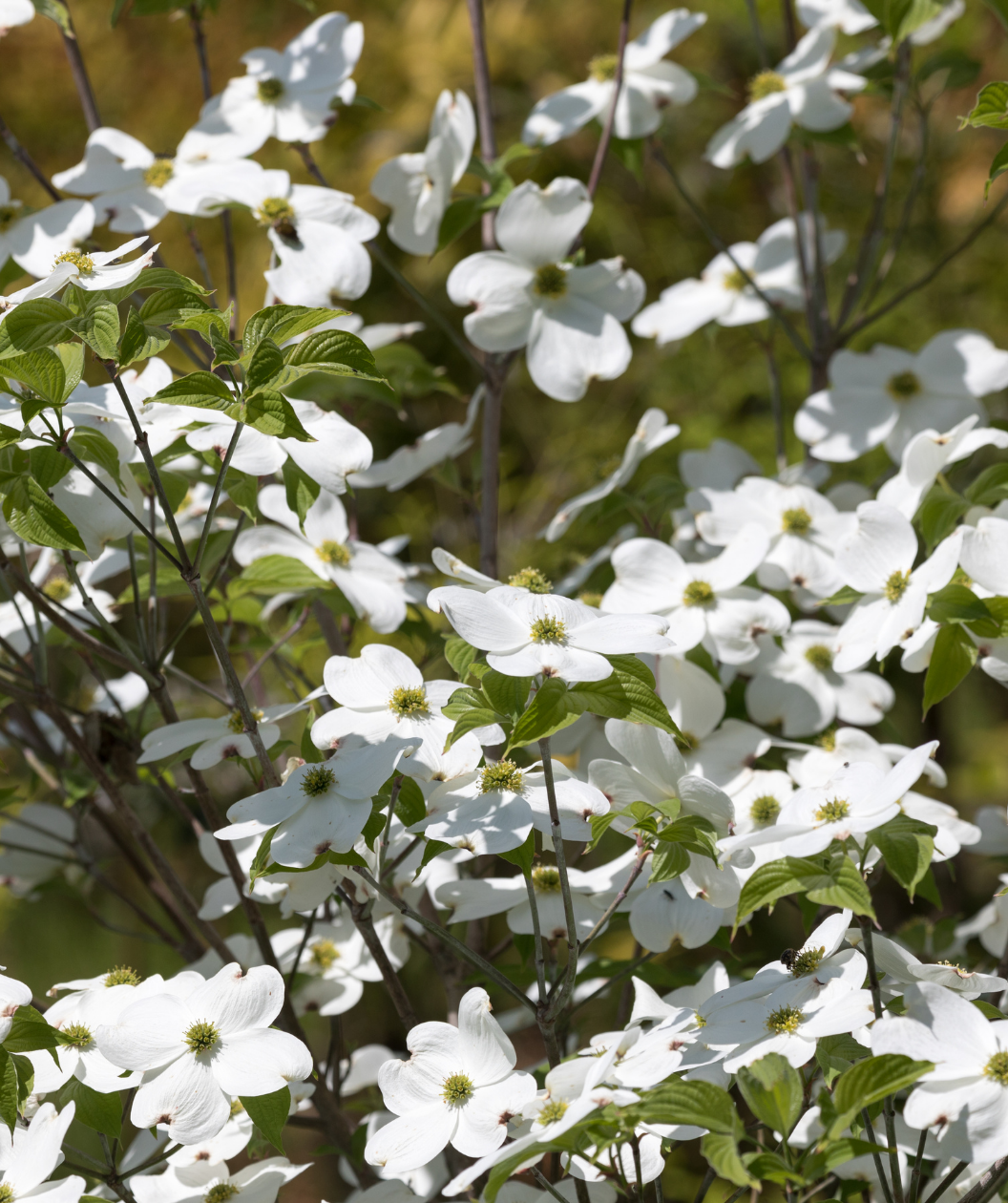


BEAUTIFUL CRISP, WHITE FLOWERING DOGWOOD
FEATURES:
- Crisp white, four-petalled flowers bloom in abundance in the spring
- Fall brings lovely shades of purple and red leaves
- From summer to winter, you'll enjoy watching birds fest on the glossy red berries
- This bird-friendly native tree provides food and shelter for local and migrating birds and other wildlife
- Wonderful when planted as a specimen tree, lining your driveway or in a wildlife garden
- Hand selected fresh from our grower
Growth Facts
- Hardiness Zone: 5-9
- Mature Height: 20-25' tall
- Mature Width: 20-25' wide
- Exposure: Full Sun/Part Shade
- Spacing: 20-25' apart
BEAUTIFUL CRISP, WHITE FLOWERING DOGWOOD
FEATURES:
- Crisp white, four-petalled flowers bloom in abundance in the spring
- Fall brings lovely shades of purple and red leaves
- From summer to winter, you'll enjoy watching birds fest on the glossy red berries
- This bird-friendly native tree provides food and shelter for local and migrating birds and other wildlife
- Wonderful when planted as a specimen tree, lining your driveway or in a wildlife garden
- Hand selected fresh from our grower
Growth Facts
- Hardiness Zone: 5-9
- Mature Height: 20-25' tall
- Mature Width: 20-25' wide
- Exposure: Full Sun/Part Shade
- Spacing: 20-25' apart
Why plant White Flowering Dogwood?
This is a tree you’ll want to have right outside your window! Flowering Dogwood puts on several performances throughout the year, and you’ll want a front-row seat for all of them. In spring, big blossoms crowd the branches like flocks of white butterflies. In early fall, the foliage turns smoldering shades of purple and red. But from late summer until well into winter, that’s when the real show happens if you’re a fan of backyard birds. Bluebirds, robins, cardinals, Cedar Waxwings, grosbeaks, mockingbirds, and Blue Jays are some of the many birds that come to feast on Flowering Dogwood’s glossy red fruits.
Arguably the most spectacular of our country’s flowering trees, Flowering Dogwood is a national treasure. All who encounter it can’t help but fall in love with it! It is the state tree of Virginia and Missouri and the state flower of North Carolina. Thomas Jefferson was a fan, and he planted many specimens at Monticello, as did George Washington at Mt. Vernon. In those days, Flowering Dogwood was valued not only for its beauty but also for the supposed efficacy of its bark and roots in a treatment for malaria. Its native range extends from Massachusetts to Florida and west to southern Michigan and East Texas.
How to use White Flowering Dogwood in the landscape?
Like so many of our native plants, Flowering Dogwood is a host to many caterpillars and other insects that our local songbirds depend on for nourishment. Bugs are not all bad! Even before the fruits are present, Flowering Dogwood will attract birds to your yard who are looking for a meal. Be sure to plant this stunning native in a location for you to enjoy the blooms, the fall color and the wildlife show it'll bring!
Planting Zones
Hardiness Zones: 5-9
How To Plant White Flowering Dogwood
Flowering Dogwoods are vulnerable to a few troublesome pests and diseases, including anthracnose, borers, and powdery mildew. However, proper siting and culture will give your tree a good chance for a long, healthy life. Site your tree in an area with morning sun and good air circulation, and don’t use overhead sprinklers. Be careful to never gouge the bark, as wounds can create an entry point for pests or disease, and prune out any dead branches and dispose of them—do not compost them.
How To Water
Water regularly after initial planting. Once established, they are more tolerant of drought conditions, reducing your hand-watering responsibilities.
How To Fertilize
Incorporate Elements Starter Plant Food granular form into the soil when planting. If planting in spring or summer start fertilizing late fall using Elements Starter Plant Food granular form on an annual basis each fall. Continue this for the first three years to get your plant well established.
How To Prune
As your tree grows, you’ll probably want to remove the lowermost branches to show off that amazing jigsaw-puzzle bark! Pruning is best done shortly after the flowers are spent.
How Does Shipping Work?
Bower & Branch Trees, the real BIG trees, don’t fit in a box! Our big trees, sizes XL and bigger, require expert delivery and care, that means our extra-large trees are shipped on Bower & Branch trucks. We are the only ones who know how to ship our big and bigger trees and plants with tender loving care. We deliver your trees and plants directly to you. Ask Bower & Branch about planting services – we'd be happy to assist in installation.
*For Big trees and Shrubs, Size XL and bigger: Review our Seasonal Shipping Timelines and Policy here.
Your trees and plants are grown across the United States at various Bower & Branch Growers. Depending on your location, your plant orders may be shipped from various locations. Please expect orders with multiple items to be delivered over a number of days as a result. Orders made up of numerous items or selections will not arrive at your home on the same day.
Shipping Delays:
From time to time, Bower & Branch Growers may determine to delay order shipment based on various factors for plant health. Weather in your region, as well as, where your plants are grown, is always considered when shipping. Extreme weather conditions may delay some or all of your order. Bower & Branch allows our Growers to make final shipping decisions based solely to benefit your trees and plants’ health and success.
How Does Sizing Work?
The size of our trees have nothing to do with the container size like you may find elsewhere–big doesn't mean just height - it’s also vigor, age, and overall health. Other online retailers are going to tell you that a plant is a seven gallon, that means nothing to your tree or plant (or you.)
Our trees for sale online are graded on large, x-large, and even bigger sizes. This is because our trees are sized by their age—the higher the letter, the more mature the tree. The age determines the trees’ overall height, size of the trunk and the overall branch density.
All of these characteristics are what you should be looking for when choosing a tree for immediate impact and instant curb appeal. Our extra-large tree and plant sizes are sure to wow you and your neighbors!
See the size guides below.






Our Guarantees
3-YEAR-TREE GUARANTEE:
Bower & Branch offers a Three-Year Tree Guarantee on all of our trees, sizes X-Large and up. Only the finest and the most experienced growers are awarded the opportunity to grow for Bower & Branch, so we offer the best guarantee available.
If your tree(s) should fail for any reason during the three-year guarantee period, you will receive an online gift card in the amount that you originally spent on the tree.* You can then use this online gift card for any Bower & Branch Purchase.
* Bower & Branch provides online gift cards in the amount of the original purchase price of the tree(s). The amount does not include any additional costs such as delivery, planting, tax, or any other products or services. Online gift cards can be applied towards any Bower & Branch purchase on BowerandBranch.com and have no expiration dates. Bower & Branch does not guarantee tree replacement or availability of any desired product at any time. Cash refunds are not offered. Bower & Branch requires that all original tags and receipts are present when a guarantee request is initiated. The Bower & Branch Three-Year Guarantee only applies to plant material that has been planted in the ground. Container plantings are NOT covered.
At Bower & Branch, we do our best to honor all guarantee fulfillment requests to ensure customer satisfaction. However, we reserve the right to refuse the request if the required guarantee steps were not satisfied. Bower & Branch also reserves the right to deny any guarantee fulfillment request that is made as a result of animal damage, problems with plant hardiness and zone issues, or acts of nature (snow storms, hurricanes, and similar).
Reach out to a Plant Whisperer with any questions:
- Email: plantwhisperers@bowerandbranch.com
- Phone: 866-873-3888
- Or via Online Chat




